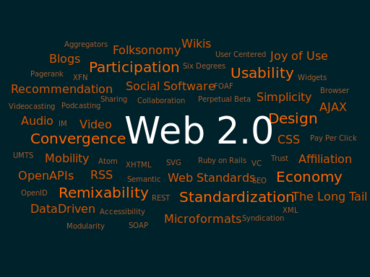Third wave
 It seems like only yesterday that we were hearing that Web 2.0 was the new operating system of the Internet. Pause to look up. It was 2008, in the short window between the founding of today's social media giants (2004-2006) and their smartphone-accelerated explosion (2010).
It seems like only yesterday that we were hearing that Web 2.0 was the new operating system of the Internet. Pause to look up. It was 2008, in the short window between the founding of today's social media giants (2004-2006) and their smartphone-accelerated explosion (2010).
This week a random tweet led me to discover Web3. As Aaron Mak explains at Slate, "Web3" is an idea for running a next-generation Internet on public blockchains in the interests of decentralization (which net.wars has long advocated). To date, the aspect getting the most attention is decentralized finance (DeFi, or, per Mary Branscombe, deforestation finance), a plan for bypassing banks and governments by conducting financial transactions on the blockchain.
At Freecode, Nader Dabit goes into more of the technical underpinnings. At Fabric Ventures (Medium), Max Mersch and Richard Muirhead explain its importance. Web3 will bring a "borderless and frictionless" native payment layer (upending mediator businesses like Paypal and Square), bring the "token economy" to support new businesses (upending venture capitalists), and tie individual identity to wallets (bypassing authentication services like OAuth, email plus password, and technology giant logins), thereby enabling multiple identities, among other things. Also interesting is the Cloudflare blog, where Thibault Meunier states that as a peer-to-peer system Web3 will use cryptographic identifiers and allow users to selectively share their personal data at their discretion. Some of this - chiefly the robustness of avoiding central points of failure - is a return to the Internet's original design goals.
Standards-setter W3C is working on at least one aspect - cryptographically verifiable Decentralized Identifiers, and it's running into opposition, from Google, Apple, and Mozilla, whose browsers control 87% of the market.
Let's review a little history.
The 20th century Internet was sorta, kinda decentralized, but not as much as people like to think. The technical and practical difficulties of running your own server at home fueled the growth of portals and web farms to do the heavy lifting. Web design went from plain text (see for example, Live Journal and Blogspot (now owned by Google). You can argue about how exactly it was that a lot of blogs died off circa 2010, but I'd blame Twitter, writers found it easier to craft a sentence or two and skip writing the hundreds of words that make a blog post. Tim O'Reilly and Clay Shirky described the new era as interactive, and moving control "up the stack" from web browsers and servers to the services they enabled. Data, O'Reilly predicted, was the key enabler, and the "long tail" of niche sites and markets would be the winner. He was right about data, and largely wrong about the long tail. He was also right about this: "Network effects from user contributions are the key to market dominance in the Web 2.0 era." Nearly 15 years later, today's web feels like a landscape of walled cities encroaching on all the public pathways leading between them.
Point Network (Medium) has a slightly different version of this history; they call Web 1.0 the "read-only web"; Web 2.0 the "server/cloud-based social Web", and Web3 the "decentralized web".
The pattern here is that every phase began with a "Cambrian" explosion of small sites and businesses and ended with a consolidated and centralized ecosystem of large businesses that have eaten or killed everyone else. The largest may now be so big that they can overwhelm further development to ensure their future dominance; at least, that's one way of looking at Mark Zuckerberg's metaverse plan.
So the most logical outcome from Web3 is not the pendulum swing back to decentralization that we may hope, but a new iteration of the existing pattern, which is at least partly the result of network effects. The developing plans will have lots of enemies, not least governments, who are alert to anything that enables mass tax evasion. But the bigger issue is the difficulty of becoming a creator. TikTok is kicking ass, according to Chris Stokel-Walker, because it makes it extremely easy for users to edit and enhance their videos.
I spy five hard problems. One: simplicity and ease of use. If it's too hard, inconvenient, or expensive for people to participate as equals, they will turn to centralized mediators. Two: interoperability and interconnection. Right now, anyone wishing to escape the centralization of social media can set up a Discord or Mastodon server, yet these remain decidedly minority pastimes because you can't message from them to your friends on services like Facebook, WhatsApp, Snapchat, or TikTok. A decentralized web in which it's hard to reach your friends is dead on arrival. Three: financial incentives. It doesn't matter if it's venture capitalists or hundreds of thousands of investors each putting up $10, they want returns. As a rule of thumb, decentralized ecosystems benefit all of society; centralized ones benefit oligarchs - so investment flows to centralized systems. Four: sustainability. Five: how do we escape the power law of network effects?
Gloomy prognostications aside, I hope Web3 changes everything, because in terms of its design goals, Web 2.0 has been a bust.
Illustrations: Tag cloud from 2007 of Web 2.0 themes (Markus Angermeier and Luca Cremonini, via Wikimedia.
Wendy M. Grossman is the 2013 winner of the Enigma Award. Her Web site has an extensive archive of her books, articles, and music, and an archive of earlier columns in this series. Stories about the border wars between cyberspace and real life are posted occasionally during the week at the net.wars Pinboard - or follow on Twitter.